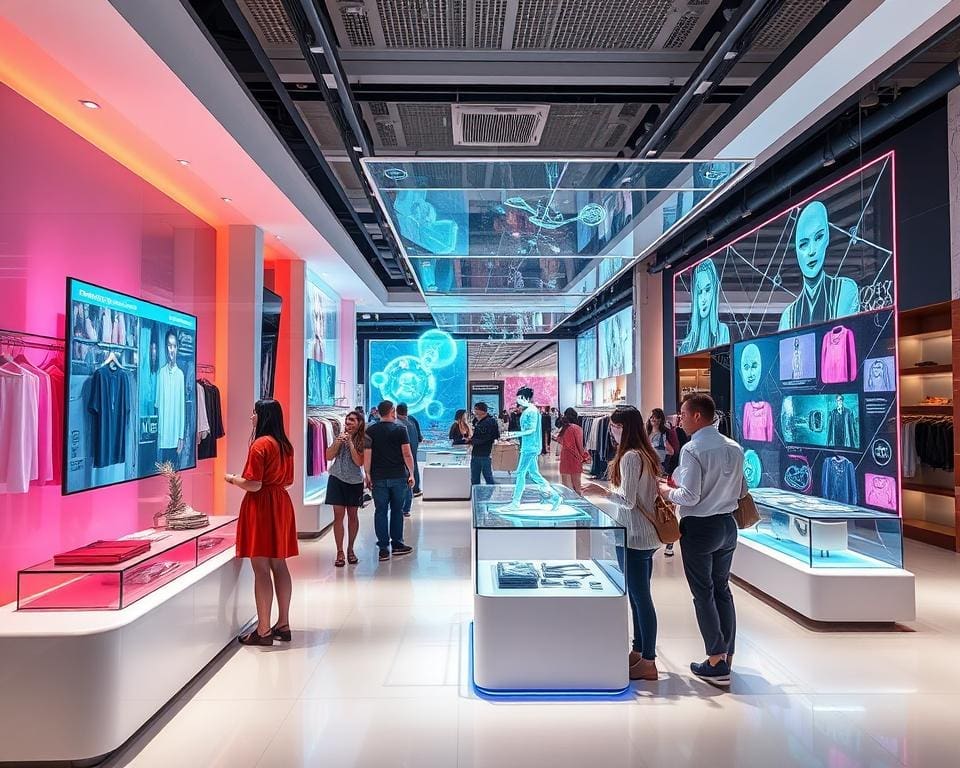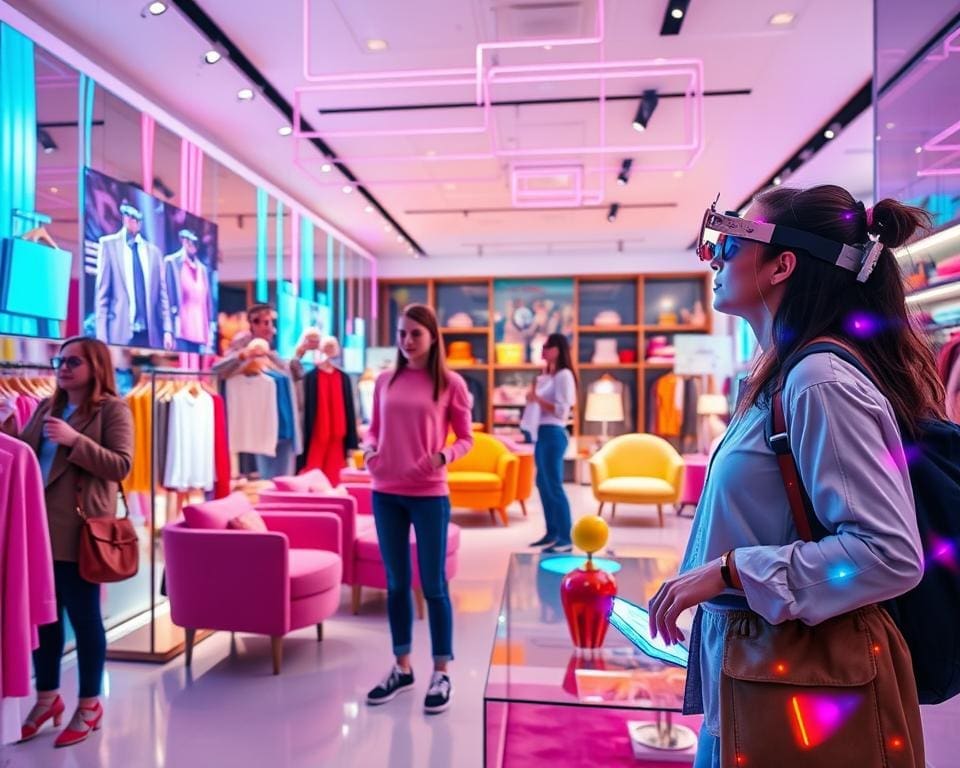In today’s rapidly evolving landscape, Augmented Reality (AR) is emerging as a game-changer in the realm of retail innovation. By seamlessly overlaying digital information onto the physical world, AR technology is enhancing the shopping experience for consumers, revolutionising how they engage with products. High-profile brands like IKEA and Sephora are leading the charge, utilising AR to allow customers to visualise items in their own environments or virtually try on products. This article delves into the exciting ways in which AR is fostering digital transformation in shopping, captivating consumers, and transforming traditional retail paradigms.
Understanding Augmented Reality in Retail
Augmented Reality (AR) represents a profound shift in how consumers interact with products in retail environments. As shoppers seek more immersive experiences, Understanding Augmented Reality becomes essential for retailers aiming to innovate and engage. This transformative technology blends digital components with the real world, providing unique ways to enhance customer experiences.
What is Augmented Reality?
At its core, AR is a technology that superimposes computer-generated content over a user’s view of the real world. This capability enhances reality by adding layers of information, producing interactivity that appeals to the consumer’s senses. In retail, the application of AR can create engaging scenarios where shoppers experience a deeper connection to the products they desire.
How AR Technology Works in Retail
AR technology in retail can be accessed through smartphones, tablets, or AR glasses, transforming how customers browse and shop. When using these devices, shoppers can view items with added insights regarding size, colour, stock availability, and current promotions. Such AR applications facilitate engaging features like virtual fitting rooms and interactive product demonstrations, effectively merging physical and digital shopping realms.

Augmented Reality: Tech Transforming Shopping
In an era where customer engagement is paramount, Augmented Reality (AR) emerges as a transformative force in retail. Retailers are adopting AR technologies to enhance the retail experience, creating immersive and interactive shopping environments that resonate with modern consumers.
Enhancing the Retail Experience
AR benefits extend beyond mere novelty, providing consumers with a personalised shopping journey. Through visualisation tools, shoppers can see how products might fit into their lives, whether it’s placing furniture in their homes or trying on clothes virtually. This capability vastly improves customer satisfaction, making the decision-making process less daunting.
The interactive nature of these applications fosters deeper customer engagement. Shoppers become active participants rather than passive observers, fostering a sense of ownership over their decisions. This level of involvement can lead to higher conversion rates as consumers feel more confident in their purchases.
As reported, retailers leveraging AR technology have noted substantial improvements in customer retention and loyalty. The enhanced retail experience encourages repeated visits and boosts overall sales performance. By delivering these interactive shopping opportunities, brands can build lasting relationships with their customers, ensuring that they return for more.
The Rise of Virtual Shopping Experiences
The landscape of retail is undergoing a profound transformation as consumers increasingly favour virtual shopping experiences. This shift has been largely driven by the recent pandemic, encouraging a significant consumer behaviour change. Shoppers now seek interactive and engaging online environments where they can connect with brands in meaningful ways. The implementation of augmented reality (AR) plays a pivotal role, enabling customers to browse as if they were physically present in a store.
Shifting Consumer Behaviour
With many traditional shopping methods disrupted, consumers have turned to online platforms for their retail needs. The expectation for engaging, informative, and immersive experiences has risen remarkably. This trend underscores the importance of AR technology, which provides unique avenues for interaction. Brands that have embraced AR features report enhanced engagement and loyalty from their customers, highlighting the critical need for innovative solutions in retail.
Examples of Successful AR Implementations
Numerous successful case studies illuminate the effective application of AR in retail. Notable examples include IKEA’s Place app, allowing users to visualise furniture within their own space before making a purchase. L’Oréal’s AR app also stands out, enabling customers to try on makeup virtually. These AR implementations exemplify how technology can bridge the gap between retailers and consumers, creating an enriched and interactive shopping journey.
Retail Innovation Through AR Technologies
Augmented Reality (AR) is revolutionising the way consumers shop, making it possible to create smart retail solutions that significantly enhance the shopping experience. As retailers increasingly adopt AR technologies, they are finding innovative ways to streamline the retail process and elevate customer satisfaction.
Smart Retail Solutions for Enhanced Shopping
Retailers are implementing various smart retail solutions that utilise AR to simplify the shopping journey. These innovations include:
- Mobile navigation tools within stores, guiding customers to specific products.
- Real-time promotions and offers delivered straight to shoppers’ devices.
- Interactive experiences that allow customers to engage with products in unique ways.
This integration of AR technology not only enhances convenience but also creates an engaging and dynamic shopping atmosphere, ultimately transforming the retail landscape.
The Role of AR in Product Visualisation
AR product visualisation plays a pivotal role in aiding consumers to make informed purchasing decisions. With the ability to view products in their intended environment, customers can more accurately gauge dimensions, features, and variations. Key benefits include:
- Increased confidence in purchase decisions, particularly in sectors like furniture and fashion.
- A notable reduction in return rates, as consumers have a clearer understanding of their selections.
- Enhanced engagement that results in a more immersive shopping experience.
Retailers embracing AR for product visualisation are reporting significant improvements in sales performance and customer satisfaction, making it a crucial aspect of modern retail innovation.
E-commerce Revolution: Integrating AR
The landscape of online shopping is experiencing a profound transformation due to the e-commerce revolution, driven by the capabilities of integrating AR technology. Retailers are embracing this innovative approach, reshaping how consumers interact with products and enhancing their shopping journey.
Transforming Online Shopping
AR in e-commerce offers a remarkable opportunity for retailers to engage customers by bringing products to life within their environments. This technology allows users to visualise how items will fit into their lives before making a purchase decision. The integration of AR functionality has led to significant advancements in customer experiences, with various benefits including:
- Reduced return rates: When shoppers can virtually experience a product first-hand, the likelihood of dissatisfaction diminishes, resulting in fewer returns.
- Increased engagement: Utilising AR captures customer interest and prolongs interactions with online platforms.
- Enhanced decision-making: Customers can compare products and assess suitability more effectively, leading to informed purchases.
This online shopping transformation not only boosts customer satisfaction but also directly correlates with improved sales outcomes. As retailers continue to embrace AR technologies, the future of e-commerce appears increasingly promising and dynamic.
Future Trends in Digital Shopping Transformation
The retail landscape is on the brink of a significant evolution, with future trends pointing towards an enhanced role for augmented reality (AR) in shaping the shopping experience. As AR developments progress, expect improvements in visual fidelity and loading times, creating an even more engaging environment for consumers. Seamless integration with e-commerce platforms will further elevate digital shopping transformation, allowing customers to navigate effortlessly between virtual and physical realms.
Moreover, retailers are likely to channel their efforts into utilising customer data more effectively within AR applications. By harnessing this information, brands can deliver personalised experiences that resonate deeply with individual shoppers. This shift will not only augment sales but also foster loyalty, elevating the overall retail future.
As these trends unfold, consumer interactions with brands are set to become more immersive and intuitive. The ongoing advancements in AR technology promise to redefine the way individuals shop, creating unique pathways that are tailored to personal preferences. In this new landscape, the fusion of AR with retail practices will usher in a transformative era, making shopping not only a necessity but also an exciting journey.









